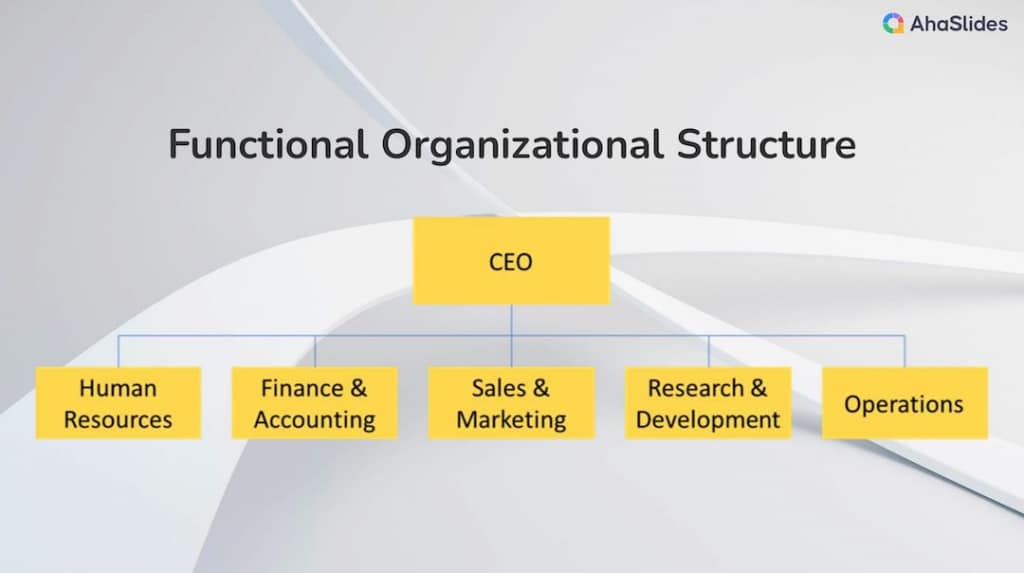Have you ever wondered how large companies organize themselves amid all the moving parts?
While some businesses operate as one cohesive unit, many establish distinct departments based on function. This is known as a functional organizational structure.
Whether it’s marketing, finance, operations, or IT, functional structures partition teams according to specialty.
On the surface, this separation of duties seems clear - but how does it really impact collaboration, decision-making, and the overall business?
In this post, we’ll take a look under the hood of the functional model and its benefits. Dive right in!
| What are functional organization examples? | Scalable, Starbucks, Amazon. |
| What type of organization is well-suited for a functional organizational structure? | Large companies. |
Table of Content
- What is a Functional Organizational Structure?
- Advantages of Functional Organizational Structure
- Disadvantages of Functional Organizational Structure
- Overcoming the Challenges of Functional Organizational Structure
- When is a Functional Structure Suitable?
- Examples of Functional Organizational Structure
- Key Takeaways
- Frequently Asked Questions
More Tips with AhaSlides

Looking for More Fun During Gatherings?
Gather your team members by a fun quiz on AhaSlides. Sign up to take free quiz from AhaSlides template library!
🚀 Grab Free Quiz☁️
What is a Functional Organizational Structure?

Many companies choose to organize themselves into different departments based on the types of jobs or tasks people do, dividing work into more specialized jobs.
This is called having a "functional organizational structure". Instead of grouping everyone who works on the same project together, people are grouped by the general area of their work - things like marketing, finance, operations, customer service, and such.
So for example, everyone who creates ads, runs social media campaigns, or thinks of new product ideas would be in the marketing department. All the accountants who track money, pay bills and file taxes would be together in finance. Engineers would work alongside other engineers in operations.
The idea is that by putting everyone with similar job skills together, they can help each other out and learn from each other's expertise. Things like financial procedures can also be standardized across the whole department.
This structure makes it very efficient because specialists don't have to constantly look for answers outside their department. But it can also make it hard for different areas to collaborate well on bigger projects that require many skills. Communication between departments may also get lost sometimes.
Overall, functional structures are good for established companies where processes are set, but companies need to find ways to bring people together trans-departmentally too to avoid working in their own silos too much.
Advantages of Functional Organizational Structure

The key benefits of functional organizational structure are explored below:
- Specialization of labor - People gain expertise in their specific function by focusing only on those tasks. This leads to higher productivity.
- Centralization of expertise - Similar expertise is pooled together within each department. Employees can learn from and support each other.
- Standardization of practices - Common ways of working can be developed and documented within each function for consistency.
- Clear lines of reporting - It's clear who employees report to based on their role, without matrix reporting to multiple managers. This streamlines decision-making.
- Flexible allocation of resources - Labor and capital can be shifted around more easily within departments based on changing priorities and workload.
- Economy of scale - Resources like equipment and employees can be shared within each department, reducing costs per unit of output.
- Ease of monitoring performance - Department metrics can be more clearly tied to goals and outcomes since functions are separate.
- Career development opportunities - Employees can advance their skills and careers by moving between roles within their specialized field.
- Management simplification - Each department head has authority over a single homogeneous unit, making management less complex.
So in summary, a functional structure promotes specialization, leverage of expertise, and operational efficiency within individual functions.
Disadvantages of Functional Organizational Structure

On the other side of the coin, a functional organizational structure is not completely flawless. Companies should consider these potential setbacks:
- Silo mentality - Departments may focus only on their own goals rather than the goals of the overall organization. This hinders collaboration.
- Duplication of efforts - The same tasks may be performed repeatedly in different departments rather than streamlined across functions.
- Slow decision-making - Issues that cut across departments take longer to resolve as they require coordination between silos.
- Poor customer service - Customers interacting with multiple departments may receive an inconsistent or fragmented experience.
- Complex processes - Work that requires cross-functional cooperation can become tangled, inefficient, and frustrating.
- Inflexibility to change - It's difficult to shift and align resources quickly when market needs change or new opportunities arise.
- Difficulty evaluating trade-offs - Broader impacts of functional decisions may be overlooked without consideration of interdependencies.
- Overdependence on supervisors - Employees rely heavily on their department leader rather than developing a big-picture perspective.
- Stifled innovation - New ideas requiring input from various areas have a harder time gaining support.
Functional silos, slow decision-making, and lack of collaboration can undermine efficiency and flexibility for an organization that has this structure.
Overcoming the Challenges of Functional Organizational Structure
It can be hard for different work groups like marketing, sales, and support to connect if they're always in their own corners. But isolating actually makes it tough to get things done. Here are some ideas to overcome the challenges:
Make projects with people from different areas. This introduces everyone and has them help each other.
Pick people to help units bond. Appoint product/client managers, they will make sure everyone shares updates and solves issues together.
Focus on shared goals, instead of each area doing its own thing, align around big company dreams they all support.
Consolidate duplicate roles like HR or IT so one team serves all vs. splitting work.
Set meetings where areas briefly update each other on what's happening. Nip issues in the bud.

Invest in collaboration tools - technologies like intranets, docs/file sharing, or project management apps can facilitate coordination.
Promote flexible rotations. Let the employees try other roles elsewhere temporarily to better understand each other and develop a different perspective.
Track teamwork too. Pay attention to how well people get along and the team's overall KPIs, not just individual achievements. Give leaders incentives to focus on organizational synergy, not just functional KPIs.
Finally, encourage social interaction so each department becomes more comfortable approaching each other for help. Finding ways for functions to interact and work as an interdependent whole will help to break down silos.
Break the ice with AhaSlides
Help each department connect and bond with AhaSlides' interactivities. Essential for companies' bonding sessions!🤝

When is a Functional Structure Suitable?

Check the list to see if your organization is the right fit to form this structure:
☐ Established companies with standardized operations - For mature companies whose core processes and workflows are well-defined, specialization within functions can promote efficiency.
☐ Stable business environment - If the market and customer needs are relatively predictable, functional groups can focus on optimizing their specialist areas without needing rapid cross-department collaboration.
☐ Tasks requiring dedicated expertise - Certain jobs like engineering, accounting, or legal work rely heavily on deep technical skills and are well-suited to a functional structure.
☐ Prioritizing operational execution - Functional structures are extremely efficient when the organization prioritizes producing or delivering a product or service; separating specialized steps amongst functions can streamline execution.
☐ Large organizations with scale - Very large companies with thousands of employees may organize into functions just to manage complexity across multiple business units.
☐ Resource allocation matters most - For capital-intensive industries, a structure that facilitates precise allocation of specialized resources and equipment works well.
☐ Traditionally bureaucratic cultures - Some established companies prefer highly departmentalized setups for control and oversight.
Examples of Functional Organizational Structure

Technology Company:
- Marketing department
- Engineering department
- Product development department
- IT/Operations department
- Sales department
- Customer Support department
Manufacturing Company:
- Production/Operations department
- Engineering department
- Procurement department
- Quality Control department
- Logistics/Distribution department
- Sales and Marketing department
- Finance and Accounting department
Hospital:
- Nursing department
- Radiology department
- Surgery department
- Labs department
- Pharmacy department
- Administrative/Billing department
Retail Store:
- Store operations department
- Merchandising/Buying department
- Marketing department
- Finance/Accounting department
- HR department
- Loss Prevention department
- IT department
University:
- Different academic departments like Biology, English, History, and such
- Student Affairs department
- Facilities department
- Sponsored Research department
- Athletics department
- Finance and Administrative department
These are some examples of how companies in different industries may group specialized roles and functions into departments to form a functional organizational structure.
Key Takeaways
While dividing work into specialized departments has its benefits, it's easy for silos to form between groups. To really succeed, companies need cooperation as much as mere specialties.
At the end of the day, we're all on the same team. Whether you create products or deliver customer service, your work supports others and the company's overall mission.
💡 See also: The 7 Types of Organizational Structure You Need to Know.
Frequently Asked Questions
What are the 4 functional organizational structures?
The four functional organizational structures are Functional, divisional, matrix, and network structure.
What is meant by functional structure?
A functional organizational structure refers to how a company divides its labor and departments based on the functions or lines of work involved while operating.
Is McDonald's a functional organizational structure?
McDonald's has a divisional organizational structure where each division serves a specific geographical location and operates almost independently with its own separate departments such as marketing, sales, finance, legal, supply, and such.







